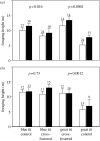Learning the ecological niche
- PMID: 17015332
- PMCID: PMC1679873
- DOI: 10.1098/rspb.2006.3663
Learning the ecological niche
Abstract
A cornerstone of ecological theory is the ecological niche. Yet little is known about how individuals come to adopt it: whether it is innate or learned. Here, we report a cross-fostering experiment in the wild where we transferred eggs of blue tits, Cyanistes caeruleus, to nests of great tits, Parus major, and vice versa, to quantify the consequences of being reared in a different social context, but in an environment otherwise natural to the birds. We show that early learning causes a shift in the feeding niche in the direction of the foster species and that this shift lasts for life (foraging conservatism). Both species changed their feeding niches, but the change was greater in the great tit with its less specialized feeding behaviour. The study shows that cultural transmission through early learning is fundamental to the realization of ecological niches, and suggests a mechanism to explain learned habitat preference and sympatric speciation in animals.
Figures


References
-
- Alatalo R.V, Eriksson D, Gustafsson L, Larsson K. Exploitation competition influences the use of foraging sites by tits: experimental evidence. Ecology. 1987;68:284–290. doi:10.2307/1939259 - DOI
-
- Begon M, Townsend C.R, Harper J.L. Blackwell Publishing; Oxford, UK: 2005. Ecology: from individual to ecosystem.
-
- Beltman J.B, Metz J.A.J. Speciation: more likely through a genetic or through a learned habitat preference? Proc. R. Soc. B. 2005;272:1455–1463. doi:10.1098/rspb.2005.3104 - DOI - PMC - PubMed
-
- Beltman J.B, Haccou P, ten Cate C. Learning and colonization of new niches: a first step toward speciation. Evolution. 2004;58:35–46. doi:10.1554/03-339 - DOI - PubMed
-
- Dall S.R.X, Cuthill I.C. The information costs of generalism. Oikos. 1997;80:197–202.
MeSH terms
LinkOut - more resources
Full Text Sources
